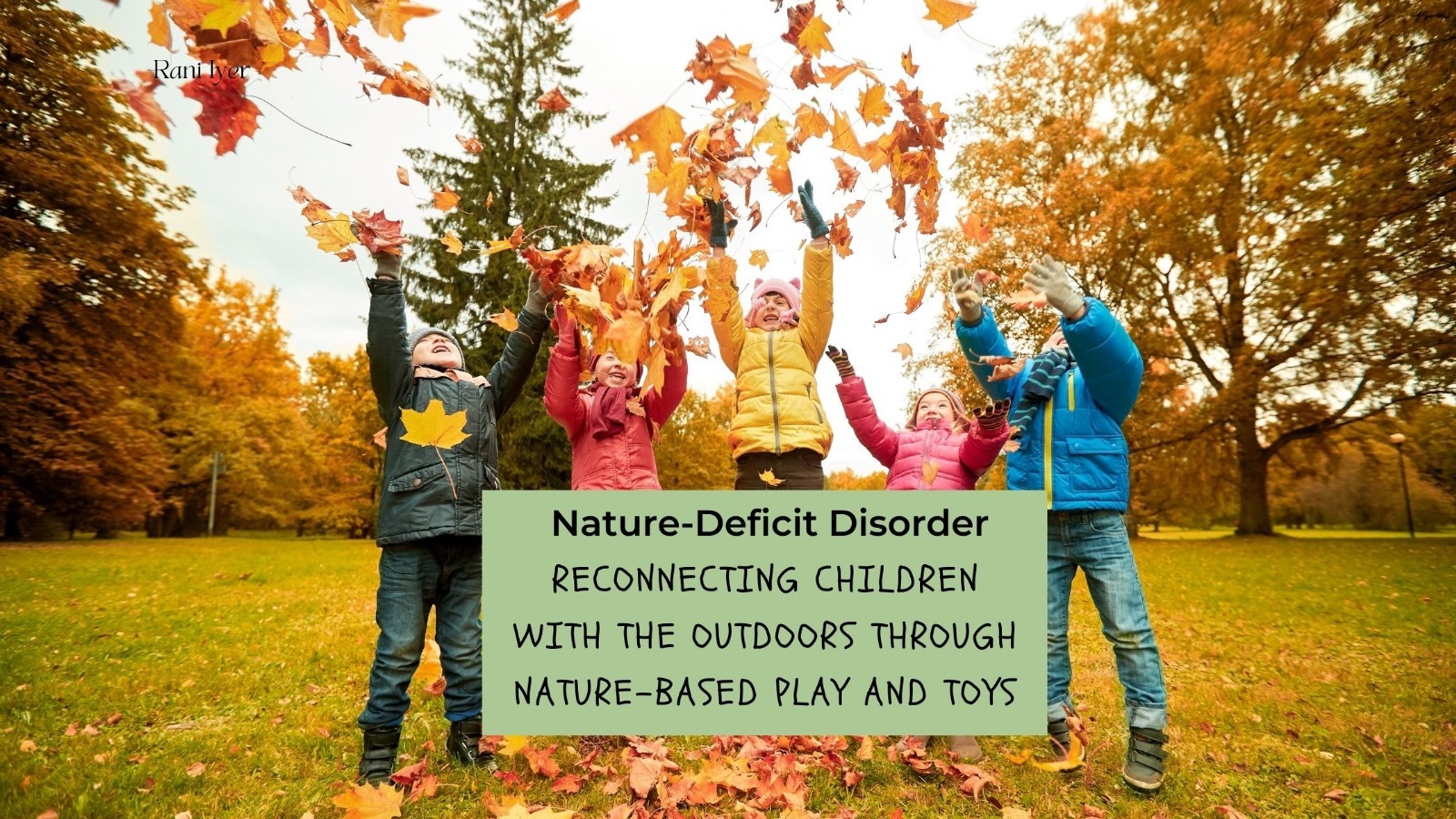In today’s digital age, a growing number of children are spending more time indoors, glued to screens, and less time exploring the great outdoors. Today’s technologically savvy generation is spending less time outdoors and connecting with nature seems to be a thing of the past. But what if this “disconnection” from the natural world is negatively impacting children’s well-being? Enter nature-deficit disorder, a term coined by author Richard Louv to describe the growing concern that children are spending significantly less time in nature, leading to detrimental effects on their mental, physical, and emotional health.
What is nature-deficit disorder?
Nature-deficit disorder is a term coined by author Richard Louv in his 2005 book “Last Child in the Woods” to describe the growing concern that children are spending significantly less time in the natural world. This phenomenon is a result of various factors, including the rise of technology, the increasing urbanization of society, and the changing lifestyles of families.
As children spend more time indoors, glued to screens and electronic devices, they are missing out on the numerous benefits that come from engaging with the natural environment. Nature-deficit disorder refers to the detrimental effects that this disconnection from the outdoors can have on a child’s physical, mental, and emotional well-being.
The concept of nature-deficit disorder highlights the importance of fostering a strong connection between children and the natural world. It suggests that this connection is essential for a child’s healthy development and that the lack of such a connection can lead to a range of negative consequences, from increased levels of anxiety and depression to decreased creativity and attention spans.
Symptoms of Nature-Deficit Disorder
The symptoms and signs of nature-deficit disorder can manifest in various ways, both physically and psychologically. Some of the most common indicators include:
Decreased physical activity and fitness levels: Children who spend less time outdoors tend to be less physically active, leading to decreased muscle strength, endurance, and overall physical fitness.
Increased screen time and sedentary behavior: With the rise of digital devices and entertainment, children are spending more time indoors, engaged with screens and passive activities, rather than actively exploring the natural world.
Reduced attention span and focus: Studies have shown that exposure to nature can improve attention, concentration, and cognitive function in children. Nature-deficit disorder can lead to decreased attention spans and difficulty focusing on tasks.
Higher levels of stress, anxiety, and depression: The calming and restorative effects of nature have been well-documented, and the lack of exposure can contribute to increased rates of mental health issues in children.
Consequences of Nature-Deficit Disorder
This shift has led to an increasing concern among educators, parents, and researchers about what is now called “Nature-Deficit Disorder” (NDD), a term popularized by author Richard Louv in his book Last Child in the Woods. Though not a medically recognized disorder, NDD refers to the physical, emotional, and cognitive problems associated with children spending less time in nature.
The impact of nature-deficit disorder on children’s well-being is far-reaching and well-documented. Studies have shown that children who spend less time in nature are more likely to experience a range of physical and mental health issues.
One of the most significant impacts of nature-deficit disorder is on children’s physical health. Children who spend more time indoors and engaged with technology are more likely to be sedentary, leading to increased rates of obesity, cardiovascular problems, and other chronic health conditions. Additionally, the lack of exposure to natural sunlight can result in vitamin D deficiency, which can have negative consequences for bone health and immune function.
The mental and emotional well-being of children is also deeply impacted by nature-deficit disorder. Numerous studies have found that children who spend more time in nature exhibit lower levels of stress, anxiety, and depression, as well as improved cognitive function, attention spans, and problem-solving skills. The calming and restorative effects of nature have been shown to be particularly beneficial for children with attention-deficit/hyperactivity disorder (ADHD) or other behavioral challenges.
To summarize, the consequences of this disconnection are significant: reduced physical activity, diminished creativity, and increased rates of anxiety, attention disorders, and even depression. But the good news is that the solution is simple, effective, and fun – encouraging outdoor play, especially through nature-based toys and activities, can help bridge the gap between children and nature, fostering better overall health and well-being.
The short and long-term impact of Nature-Deficit Disorder
Children today are experiencing nature less frequently than previous generations. Busy schedules, urban environments with limited green spaces, and the rise of digital entertainment contribute to this disconnection. Research shows that children aged 8 to 18 spend an average of over seven hours a day on screens. This leaves little room for outdoor play and nature exploration, activities that are essential for healthy development.
When children don’t engage with nature regularly, they can experience a range of issues:
- Physical Health Problems: Without enough outdoor activity, children are more prone to obesity, vitamin D deficiency, and other health complications. Natural spaces offer ample opportunities for physical exercise, whether through running, climbing, or simply exploring.
- Mental Health Concerns: Time spent outdoors has been proven to reduce stress and anxiety in children. Nature offers a calming and restorative environment that can significantly improve emotional well-being.
- Cognitive Impacts: Nature stimulates curiosity, creativity, and problem-solving skills. When children are deprived of this stimulation, they may experience lower attention spans, decreased creativity, and challenges with focus and learning.
- Social and Emotional Development: Outdoor play encourages cooperative play, communication, and social bonding. Children who miss out on these experiences may struggle with emotional resilience and social interaction.
The Power of Outdoor Play
Outdoor play is not only fun but critical for children’s development. The benefits of outdoor play and exposure to nature for children are numerous and well-documented. From improved physical health to enhanced cognitive and emotional development, engaging with the natural world can have a profound impact on a child’s overall well-being.
When children are allowed to explore, climb, build, and experiment in nature, they learn through direct experience. They develop motor skills, balance, coordination, and strength. But perhaps more importantly, they learn about themselves, their capabilities, and the world around them.
Nature-based play fosters creativity and problem-solving. In natural settings, children can turn a stick into a magic wand, a pile of rocks into a fort, and a puddle into an adventure. This unstructured, imaginative play is key to building cognitive flexibility and resilience. Furthermore, engaging in outdoor play provides children with the opportunity to take healthy risks, learn from mistakes, and gain confidence, all while being physically active.
One of the primary benefits of outdoor play and nature exposure is the positive impact on physical health. Children who spend more time outdoors are more physically active, leading to improved cardiovascular fitness, muscle strength, and overall physical development. Additionally, exposure to natural sunlight can help regulate the body’s circadian rhythms and increase vitamin D levels, which are essential for bone health and immune function.
Beyond the physical benefits, outdoor play and nature exposure also have a significant impact on a child’s cognitive and emotional development. Studies have shown that children who spend more time in nature exhibit improved attention spans, better problem-solving skills, and enhanced creativity and imagination. The calming and restorative effects of nature have also been linked to lower levels of stress, anxiety, and depression in children.
Strategies for incorporating nature into children’s daily lives
Incorporating nature into children’s daily lives is essential for combating nature-deficit disorder and promoting overall well-being. There are a variety of strategies that parents, caregivers, and educators can implement to ensure that children have ample opportunities to engage with the natural world.
One effective strategy is to create nature-rich environments within the home. This can involve setting up a small indoor garden, establishing a backyard or community garden, or even incorporating natural elements, such as plants, rocks, and natural materials, into the home’s decor. By bringing nature into the child’s immediate surroundings, parents and caregivers can foster a sense of connection and appreciation for the natural world.
Another strategy is to plan regular outdoor excursions and field trips. This can include visiting local parks, nature reserves, or even taking day trips to explore nearby natural areas. These experiences not only provide children with the opportunity to engage with nature but also offer valuable learning opportunities and the chance to develop a deeper understanding of the environment.
Nature-Based Toys: Encouraging Outdoor Exploration
One of the easiest ways to reintroduce children to nature and encourage outdoor play is through nature-based toys and activities. These toys are designed to spark curiosity, enhance imaginative play, and promote learning, all while allowing children to engage with the natural world.
Here are some ideas to help foster that connection:
- Outdoor Construction Kits: Building sets made from natural materials, such as wooden blocks or sticks, allow children to create structures in their own backyard. These toys promote problem-solving, engineering skills, and creativity.
- Gardening Kits: Introducing children to gardening gives them a hands-on understanding of the life cycle of plants. Tools such as child-sized shovels, watering cans, and seed starter kits allow them to actively participate in growing something from the ground up. Gardening also fosters patience, responsibility, and a sense of achievement.
- Nature Exploration Kits: Equip your child with tools like magnifying glasses, bug containers, and field guides to explore the world around them. These kits encourage observation, scientific thinking, and curiosity about nature.
- Climbing and Balance Toys: Encouraging physical activity through climbing trees, balancing on logs, or using rope swings can help children develop strength, balance, and coordination. These activities also support risk assessment and physical confidence.
- Water Play Sets: Toys like buckets, water wheels, and splash pads offer endless opportunities for sensory play. Water play is particularly soothing and helps children understand cause and effect while fostering creativity.
- Natural Art Supplies: Collecting items from nature, such as leaves, flowers, sticks, and rocks, can be turned into beautiful art projects. Using natural pigments or creating nature collages allows children to express themselves creatively while engaging with their surroundings.
- Outdoor Themed Board Games or Storybooks: Games and books that feature nature themes can reinforce a love for the outdoors. Whether it’s identifying animals, learning about ecosystems, or hearing tales of outdoor adventures, these activities can further a child’s connection to nature even when they are inside.
Tips for Parents: Increasing Outdoor Time
Beyond incorporating nature-based toys, parents can take several proactive steps to ensure their children spend more time outdoors:
- Lead by Example: Children often follow their parents’ habits. If they see you spending time outside, they will be more likely to follow suit. Consider turning your own activities, such as gardening or hiking, into family events.
- Limit Screen Time: Set limits on screen use and designate specific times for outdoor activities. You might find that once your child is engaged in outdoor play, they’re less likely to want to return to their screens.
- Encourage Unstructured Play: Let children create their own adventures. While organized sports and playgrounds are great, free, unstructured time in nature – where kids can wander, explore, and create on their own – is invaluable.
- Bring Nature Indoors: Even when time or space limits outdoor play, nature-based toys, indoor plants, and natural light can help bring the outdoors inside and maintain that connection to nature.
- Join Nature-Based Programs: Many communities offer outdoor education programs, nature camps, or forest schools designed to immerse children in natural environments. These programs help children develop a deeper understanding and appreciation for the natural world.
The importance of nature-based education and outdoor learning
The importance of nature-based education and outdoor learning in combating nature-deficit disorder cannot be overstated. Schools and educational institutions play a crucial role in ensuring that children have access to nature-based learning experiences and opportunities to explore the natural world.
Nature-based education, which incorporates hands-on, experiential learning in outdoor settings, has been shown to have numerous benefits for children’s academic, social, and emotional development. Studies have found that children who participate in nature-based learning programs exhibit improved academic performance, enhanced problem-solving skills, and increased engagement and motivation in learning.
Outdoor learning, which takes place in natural environments such as parks, forests, or school gardens, also offers valuable benefits for children’s well-being. By engaging with nature through activities like hiking, gardening, or wildlife observation, children can develop a deeper understanding and appreciation for the natural world, while also reaping the physical and mental health benefits associated with outdoor play and exploration.
Community initiatives and organizations promoting nature exploration for children
In recent years, there has been a growing recognition of the importance of addressing nature-deficit disorder and promoting nature exploration for children. As a result, a variety of community initiatives and organizations have emerged to support this important cause.
One example of a community initiative is the establishment of nature-based preschools and schools. These educational institutions prioritize outdoor learning and nature exploration, providing children with ample opportunities to engage with the natural world on a daily basis. By integrating nature-based activities and experiences into the curriculum, these schools help to combat nature-deficit disorder and foster a lifelong appreciation for the environment.
Another example of a community initiative is the development of nature-based afterschool and summer programs. These programs, often run by local parks departments, environmental organizations, or community centers, offer children the chance to explore natural spaces, participate in outdoor activities, and learn about the natural world. These programs not only provide a fun and engaging way for children to spend their free time but also contribute to the overall well-being and development of participants.
Overcoming barriers to outdoor play and nature experiences for children
Despite the well-documented benefits of outdoor play and nature experiences for children, there are often significant barriers that can prevent families from accessing these opportunities. These barriers can include a lack of access to green spaces, safety concerns, financial constraints, and even cultural or societal norms that prioritize indoor activities over outdoor exploration.
One of the primary barriers to outdoor play and nature experiences is the lack of access to green spaces, particularly in urban and underserved communities. Many children, especially those living in low-income neighborhoods, may not have easy access to parks, nature reserves, or other natural areas where they can safely explore and play. Addressing this issue requires a multifaceted approach, including investments in public green spaces, the creation of community gardens, and the development of nature-based programs and initiatives that are accessible to all children.
Another barrier to outdoor play and nature experiences is the perception of safety concerns. Parents and caregivers may be hesitant to allow their children to play outdoors due to fears about traffic, crime, or other potential dangers. To overcome these concerns, it is essential to promote safe and accessible outdoor spaces, educate families about the benefits of nature exploration, and work with local communities to address safety issues.
A Call for Reconnection
In an increasingly urbanized and digital world, it’s more important than ever to encourage children to reconnect with nature. Outdoor play, nature-based toys, and activities that allow them to explore, create, and imagine in natural settings are not only fun but crucial for their development.
As parents, educators, and caregivers, it’s our responsibility to provide children with opportunities to engage with the outdoors. By doing so, we are fostering healthier, happier, and more well-rounded individuals who will carry a love for nature with them into adulthood. Nature-Deficit Disorder is a growing concern, but with conscious efforts, we can begin to reverse its effects – one outdoor adventure at a time.
In conclusion, the concept of nature-deficit disorder highlights the critical importance of ensuring that children have ample opportunities to engage with the natural world. As the evidence clearly demonstrates, the lack of exposure to nature can have far-reaching consequences on children’s physical, mental, and emotional well-being.
By addressing nature-deficit disorder and prioritizing nature-based experiences for children, we can help to foster a generation of individuals who are not only healthier and happier but also more connected to the environment and better equipped to tackle the environmental challenges of the future. Through a multifaceted approach that involves parents, educators, policymakers, and community organizations, we can work to overcome the barriers to outdoor play and nature exploration and ensure that all children have the opportunity to thrive in the natural world.
Ultimately, the green prescription for children’s well-being is clear: more time in nature, less time disconnected. By heeding this call and making nature a central part of children’s lives, we can not only combat the negative effects of nature-deficit disorder but also unlock the immense potential of the natural world to nurture and nourish the next generation.



